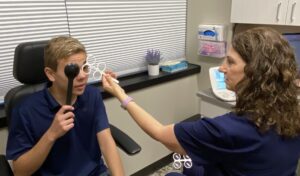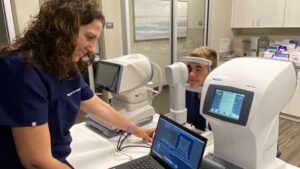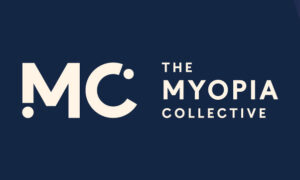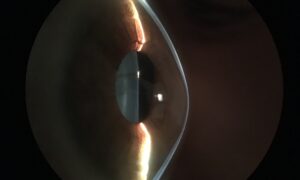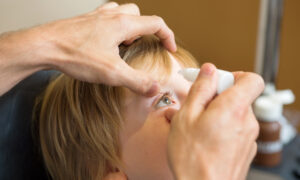June 17, 2024
By Marie Homa-Palladino, OD, FIAOMC, IACMM
My journey in the eye care field began over 40 years ago, working for a local optometrist in the business office and as a contact lens technician. As a high myope who wore contacts from a young age, I really enjoyed working with contact lens patients, and I learned quickly that I had an affinity for it.
I opened my private practice in 2009, and shortly after, I went to GSLS and heard Brien Holden speak about the myopia epidemic. I had two young daughters at the time, one already myopic at age 9, and the younger, a pre-myope. Brien inspired me to look further into orthokeratology and start offering my patients — and my children — myopia management treatments. I went on to take courses, attending Vision by Design, and it was the best conference in my career, especially for myopia and OrthoK fitting.
My first patient was my oldest daughter, and I quickly saw her amazing results and the freedom obtained with OrthoK. Her vision was fantastic, and I felt compelled to share this with everyone.
Growing My Myopia Patient Base
When I first started offering myopia management treatments to my patients, I started off slowly. In those early days, I started with one hour a day, one day a week, exclusively seeing myopes and treating them with OrthoK. As my patient base and knowledge grew, I increased my myopia management time to three hours per day, every day of the week.
After 14 years as a solo practitioner, I sold my general practice, and I’m now working for Medical Optometry America (MOA) in the Newtown Square Eye Health Center, Newtown Square, PA. At MOA, I have the unique opportunity to concentrate on myopia management, which is my passion. I am honored to be the Medical Director for MOA’s Myopia Management Center of Excellence and currently practicing exclusively in full scope myopia management with OrthoK, soft multifocal contact lenses, and low-dose atropine, along with combination treatments when necessary. Combination treatments are a necessity with young, quickly progressing children and pre-teens. I utilize different percentages of atropine with either soft myopia control lenses or OrthoK.
I create myopia management treatment programs based on my individual patient, considering risk factors such as the age of onset, axial length, and degree of myopia. I also look at the family dynamics and highlight the pros and cons of each treatment option. Some parents decide on OrthoK before they come in, and if I think it’s appropriate after the exam and talking with the patient, we stay with that. It is a very personalized experience.
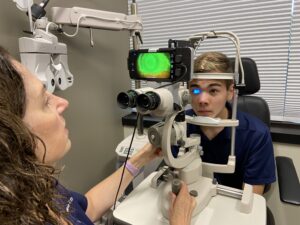 |
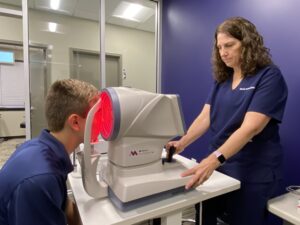 |
Dr. Homa-Palladino works with every patient to determine the best myopia management treatment plan.
Explaining the Consequences of Myopia Management
Since I work in a referral clinic, most of my patients already know they are nearsighted. However, they often do not realize what that means and the impact it can have on future eye health and vision. This is where patient communication tools such as Ocumetra and HOOT have become a real advantage. The software communicates for you, giving parents and patients information about myopia in small segments, which is easier to understand.
Effectively communicating the consequences of untreated myopia has been the biggest challenge I’ve faced with myopia management. However, we have solutions that can change their lives forever, and we over-educate and communicate with our patients and parents.
Another challenge I regularly experience is the lack of education for pediatricians and school nurses in our community. They are so busy these days, and it’s challenging to keep them updated on new information in myopia management. In my office at MOA, I send letters to local pediatricians and primary eye care doctors about our mutual patients’ care. I also always offer my time if any concerns or questions arise.
Practitioner Education is Key
Just because we’re the doctors, that doesn’t mean our learning ever stops. Staying on top of the latest myopia management research and clinical findings is paramount to always offering my patients the highest quality of care. For the most updated information about myopia management, I subscribe to journals, keep in contact with my industry partners, read Review of Myopia Management, and attend as many webinars and meetings as possible. Vision By Design has become an annual meeting that I always make time for, as the education is very in depth — even on an international level.
Social media is also an extremely important platform for us to get the word out about what is happening with our children’s vision and where we are headed. It allows us to get in front of parents and get them to pay attention to the problem — while also highlighting the fact that we have excellent options for treatment. I am very happy that our office has an excellent social media presence and keeps up with current, essential messages on a daily basis. This educates and drives people to act.
The future of myopia management lies in our hands, and the future is now. We owe it to our children to learn and practice the fundamentals of myopia and its management. We must push forward on new research into effective treatments to keep our children’s future vision safe. We also must include parents, educators, pediatricians, nurses, and the stakeholders who touch our children’s lives every day.
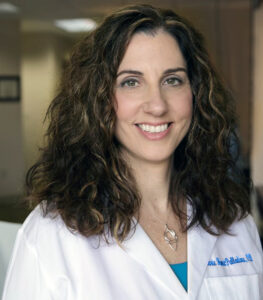 |
Marie Homa-Palladino, OD, FIAOMC, IACMM, leads the MOA Myopia Management Center of Excellence. Dr. Homa–Palladino is a nationally recognized expert in the field of myopia management. She is the only provider in the Southeastern Pennsylvania region who has earned the distinguished honor of becoming a Fellow in the International Academy of Orthokeratology and Myopia Control and the only one who specializes exclusively in this field. In addition to treating patients, Dr. Homa-Palladino is committed to advancing the field of myopia management. She lectures frequently at national meetings and sits on the Board of Directors for the American Academy of Orthokeratology and Myopia Control, serving as Secretary of the Board, member of the Executive Committee, and Chair of Staff Development. |


